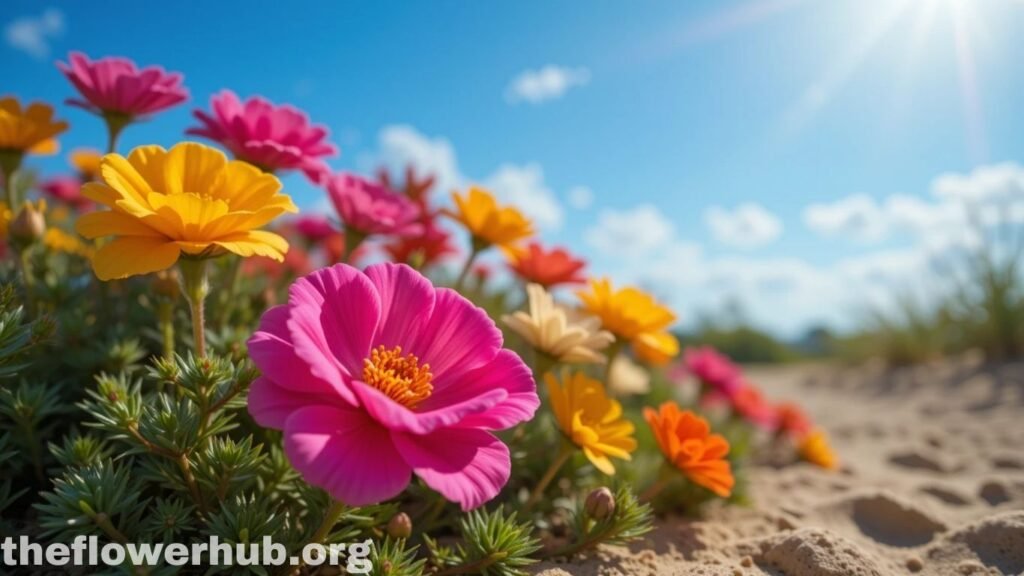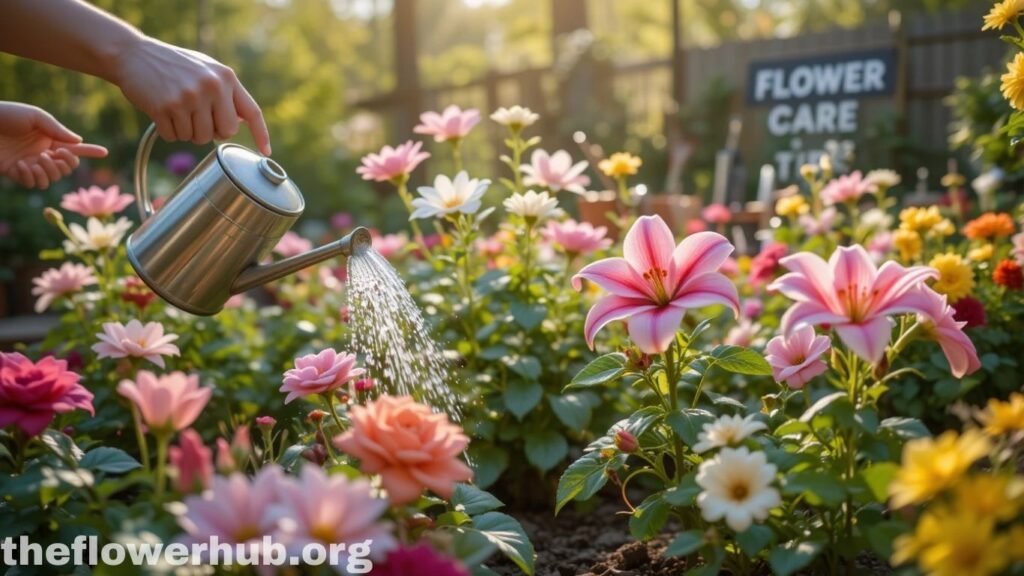Moss rose isn’t just about flowers in the garden. This easy-care bloomer brings a cheery pop of color, versatility and adorable good looks that has made it a cherished plant across the globe. In this comprehensive guide, we’ll discover fascinating facts, tips on growing, design ideas, and more for anyone who’s been thinking about bringing this cheery bloom into their outdoor spaces.
Introduction
Moss rose is beloved for its dazzling spectrum of colors, as well as its distinct, succulent-like leaves. Despite its fragile, rose-like blooms, it’s a robust plant that can survive heat and drought, and is an all-around dependable option for a range of climates and garden designs.
Table of Contents

Botanical and Plant Profile Background
The scientific name for spearmint is Mentha spicata and it is known as the garden mint.
- Botanical Name: Portulaca grandiflora
- Other Common Names: Moss rose, (sun) roze, eleven o’clock
- Family: Portulacaceae
- Original Source: South America (Brazil, Argentina, Uruguay)
Moss rose is a low-growing, succulent annual flower that blooms in summer. It is considered to be a good choice for landscaping, thanks to its ability to bloom profusely on small amounts of water.
Historical Significance
Etymology and Brief History compensatio is Latin for “compensation” and “dedication’; also the title of a novel by Wiktor Kulerski (1996).Moss rose is native to South America, so indigenous peoples have been enjoying its aesthetics and medicinal benefits for centuries. Its international dissemination started in the 19th century when it was brought to Europe and Asia by botanical gardens and plant collectors. Today it is cultivated throughout the world, particularly in arid and semi-arid areas.
Common Types of Moss Rose
The moss rose plant has many different cultivars, each with different features. Here’s a rundown of popular varieties:
| Variety | Flower color | Special feature |
|---|---|---|
| Sundance Mix | Multi | Dense, carpet-like growth |
| Margarita Mix | Rose, yellow, orange | Highly drought tolerant |
| Happy Hour Mix | Bright pink, white | Early bloomer |
| Fairy Tale | Double accented blooms | Rose-like appearance |
| Calypso Series | Red, fuchsia, peach | Compact and planting in 5-inch containers |
Ideal Growing Conditions
Sunlight
Full sun is a must. Moss rose grows best when it receives 6 to 8 hours of full sunlight each day. They will produce less flowers in partial shade.
Soil
The best soil is well-drained, sandy soil. Do not use heavy clay based soils unless amended.
Watering
Water sparingly. The Mature Plant: The tea house camellia plant, once established, is a low-maintenance shrub, and interference—such as overwatering—can be detrimental.
Temperature
Best in 70°F-100°F. Frost sensitive.
Propagation and Planting Tips
From Seeds
- Start indoors 6 weeks prior to the last frost or direct sow outdoors after the last frost.
- Sow seeds onto surface of soil and press in with fingers but DO NOT cover.
- Keep the soil moist until seedlings germinate (10–14 days).
From Cuttings
- Use 3–4 inch cuttings.
- Dry ends before planting.
- Plant in well-drained soil; roots spread rapidly.
Common Pests and Problems
Although tough, moss rose flowers can have problems with:
Pests
- Aphids: Try neem oil to control them.
- Spider Mites: Rinse plant with water or insecticidal soap.
- Slugs Less frequent, but you might find them in moist spots.
Diseases
- Root rot: Brought about by bad draining.
- Powdery Mildew: Related to leaf moisture.
Landscaping With Moss Rose
- Rock Gardens: Well-suited because of succulent nature.
- Hanging Baskets: Trailing habit is attractive.
- borders and walkways: Provide bright striking color contrast.
- Pots: Perfect for your patio or balcony.
- Zen Gardens: Pairs well with gravel and a minimalistic layout.
Benefits of Growing Moss Rose
- Drought Tolerant: Ideal for water-wise gardening.
- Attracting: Attracts bees and butterflies.
- Ground Spread: Covers ground quickly so can it be useful for ground cover.
- Easy Care: Grows well and easy to care for once it’s established.
- Versatile: Easy to be wild yet formal for any landscape garden.
Seasonal Bloom Guide
- Spring: Sow seeds indoors or direct seed after last frost.
- Early Summer: The first flowers appear, requiring full sun.
- Maintaining (deadheading) mid-summer: Best blooming.
- Late summer: Flowering becomes almost horizontal.
- Fall: Ready for reseeding, or collect seed.
Cultivated Indoors vs. Outdoors
Outdoor
- Good for religion it sees for sun.
- Plants are healthier with their natural drainage.
Indoor
- Requires grow lights or southern exposure windows.”
- For best results, use cactus potting mix.
- Turn intermittently for development all around.
How to Care for Long-Lasting Blooms

- Deadhead often to promote additional bloom.
- Feed monthly with a balanced, water-soluble fertilizer.
- Don’t water from overhead, because that will lead to leaf rot.
- Pinch back lanky stems to encourage a more compact form.
- Nurture in the winter months by moving pots inside or covering.
INFLUENCE ON THE ENVIRONMENT AND SUSTAINABILITY
Moss rose is environmentally frinedly to your garden:
- Saves Water: Requires fewer gallons of water than real flowers.
- Are a barrier to soil erosion: Ideal ground cover.
- Habitat for Pollinators: It is friendly to the local ecosystems.
- Non-Invasive: It doesn’t usually move from where it’s put.
FAQs
Q1: Is moss rose a true rose?
No. Despite its name, it is not a berry and has no familial ties to berries on plants of the genus Rosa. It looks like a rose, as a flower form.
Q2: How much do you water moss rose?
Not until the top inch of soil is dry. Once a week is usually enough.
Q3: If Frost Tolerant Moss Rose can grow in cold regions?
It loves warmth, cannot handle frost. Grow as an annual or sow seeds indoors in cooler regions.
Q4: Do deer eat moss rose?
No. Its succulent leaves generally make it deer-resistant.
Q5: Can moss rose be planted for xeriscaping?
Absolutely. It does well in arid conditions and requires less watering.
Conclusion
The unheralded moss rose So says an old adage! With it’s colourful palette, versatility and low maintenance, no sunny garden should be without it. Whether you’re growing in containers, edging walkways or creating a textural display in a rock garden, this cheery bloomer will bring long-lasting bright color with little care.
For anyone interested in building a long-lasting and pollinator-friendly garden with minimal effort, moss rose is a great selection. All you need is some sun, some sand and some water, and you’ll have months of gorgeous bloom and beauty.
Enjoy this flower’s easy care and beauty: the moss rose, a plant that prefers to grow unbothered yet explodes with unstoppable color.
